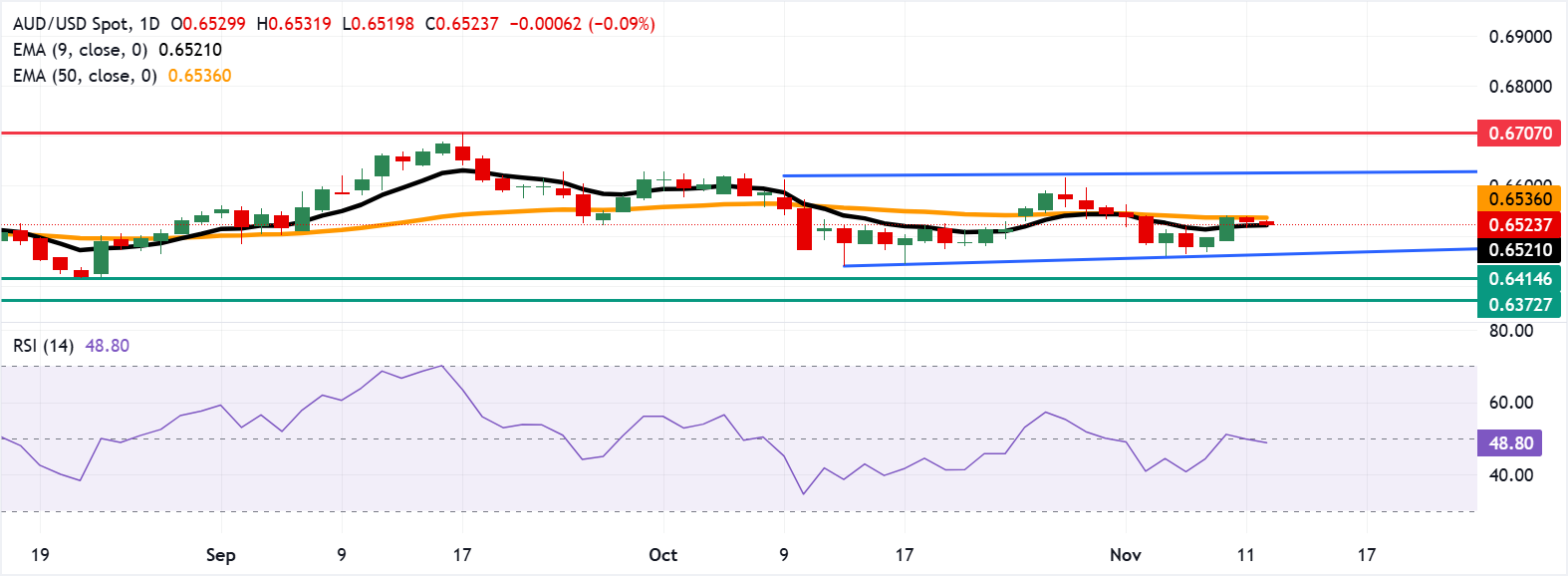Australian Dollar declines as US Dollar gains amid nearing government shutdown end
- Gold drifts higher amid growing concerns over US government shutdown
- Australian Dollar receives support following cautious remarks from RBA Hauser
- Gold draws support from safe-haven flows and Fed rate cut bets
- Forex Today: BoE policy announcements to set direction for Pound Sterling
- WTI holds near $59.50, further downside appears due to oversupply concerns
- U.S. Stock Market Opinions Diverge: Will the Market Rise or Fall Going Forward?

Australian Dollar extends its losses despite a cautious RBA policy stance.
The AUD could regain its ground as RBA’s Hauser highlighted the need to maintain tight monetary conditions.
The US Dollar edges higher on the ongoing process of the government shutdown ending.
The Australian Dollar (AUD) weakens against the US Dollar (USD) on Wednesday, extending its losses for the second successive session. The AUD/USD pair declines as the US Dollar (USD) gains support from the ongoing process to reopen the United States (US) government.
The AUD may regain support from cautious sentiment surrounding the Reserve Bank of Australia (RBA) policy outlook. On Monday, RBA Deputy Governor Andrew Hauser mentioned the unusual challenges facing monetary policy and stressed the need to maintain tight conditions to curb inflation. Hauser noted that Australia’s monetary policy is navigating a tricky phase, as the economic recovery began with demand already exceeding potential output, leaving limited room for near-term easing.
RBA Assistant Governor (Financial System) Brad Jones delivered a speech on Wednesday at the Association of Superannuation Funds of Australia (ASFA) Conference in Broadbeach. Jones noted that markets are underestimating geopolitical risks and that global valuations remain complacent. He also highlighted early signs of fragmentation appearing in central bank Gold reserves.
US Dollar receives support as government shutdown nears end
The US Dollar Index (DXY), which measures the value of the US Dollar against six major currencies, is halting its five-day losing streak and trading around 99.50 at the time of writing. Traders will likely observe the upcoming speeches from Federal Reserve (Fed) officials, including Christopher Waller, Raphael Bostic, and Stephen Miran, later in the day.
The US Senate completed its job and passed the bill that would end the government shutdown. The House will vote on the bill on Wednesday, sending it to President Donald Trump for signature. That would reopen the government, sending paychecks and unleashing economic data releases.
US President Donald Trump, on Monday, backed a bipartisan deal to end the US government shutdown, signaling a likely reopening within days. Senate Majority Leader John Thune said he expects Trump to sign the bill once Congress passes it.
President Trump issued a premonition that inflation will reach 1.5% "pretty soon", a level of inflation that has evaded the US economy for nearly four years after shooting above that level in February of 2021. 1.5% inflation is also well below the long-run average for US inflation over ten years.
US Treasury Secretary Scott Bessent said on Monday that the US federal shutdown's impact is getting worse for the economy. Making substantial progress on inflation and expecting prices to come down over the coming months, Bessent added.
Job losses in October, mainly in the government and retail sectors, and a drop in consumer sentiment to a three-and-a-half-year low in early November have reinforced expectations of policy easing. The CME FedWatch Tool shows markets pricing in a 68% chance of a 25 bps rate cut in December.
China's Ministry of Commerce said on Monday that it would temporarily lift its ban on approving exports of “dual-use items” related to gallium, germanium, antimony, and super-hard materials to the US. The suspension takes effect from Sunday until November 27, 2026. Any change in the Chinese economy could impact the AUD as China is a major trading partner for Australia.
National Bureau of Statistics of China reported on Sunday that the Consumer Price Index (CPI) climbed 0.2% year-over-year in October, recovering after a decline of 0.3% in September. The market consensus was for 0% in the reported period. CPI inflation increased 0.2% MoM in October, against 0.1% prior. Producer Price Index (PPI) dropped 2.1% YoY in October, following a 2.3% fall in September. The data came in above the market consensus of -2.2%.
University of Melbourne released on Tuesday that Australia’s Westpac Consumer Confidence jumped 12.8% in November to 103.8, surpassing 100 for the first time since February 2022. The rebound follows a 3.5% decline in October and marks the strongest non-pandemic reading in seven years, driven by improving economic conditions and easing external risks.
Australian Dollar tests nine-day EMA support near 0.6500
The AUD/USD pair is trading around 0.6520 on Wednesday. Technical analysis of the daily chart shows the pair consolidating within a rectangle pattern, trading sideways. However, the pair is positioned close to the nine-day Exponential Moving Average (EMA), indicating an unbiased short-term momentum.
A successful break below the nine-day EMA of 0.6520, followed by the psychological level of 0.6500, could weaken the short-term price momentum and prompt the AUD/USD pair to approach the lower boundary of the rectangle around 0.6470 and the five-month low of 0.6414, which was recorded on August 21.
On the upside, the AUD/USD pair could target the 50-day EMA of 0.6536. A break above this level would improve the medium-term price momentum and support the AUD/USD pair to explore the region around the rectangle’s upper boundary, around 0.6630. Further advances would support the pair to target the 13-month high of 0.6707, recorded on September 17.

Australian Dollar Price Today
The table below shows the percentage change of Australian Dollar (AUD) against listed major currencies today. Australian Dollar was the weakest against the New Zealand Dollar.
| USD | EUR | GBP | JPY | CAD | AUD | NZD | CHF | |
|---|---|---|---|---|---|---|---|---|
| USD | 0.04% | 0.16% | 0.11% | 0.06% | 0.10% | -0.01% | 0.07% | |
| EUR | -0.04% | 0.11% | 0.07% | 0.02% | 0.06% | -0.05% | 0.02% | |
| GBP | -0.16% | -0.11% | -0.02% | -0.09% | -0.06% | -0.16% | -0.09% | |
| JPY | -0.11% | -0.07% | 0.02% | -0.06% | -0.02% | -0.14% | -0.06% | |
| CAD | -0.06% | -0.02% | 0.09% | 0.06% | 0.04% | -0.08% | 0.00% | |
| AUD | -0.10% | -0.06% | 0.06% | 0.02% | -0.04% | -0.11% | -0.03% | |
| NZD | 0.00% | 0.05% | 0.16% | 0.14% | 0.08% | 0.11% | 0.08% | |
| CHF | -0.07% | -0.02% | 0.09% | 0.06% | -0.00% | 0.03% | -0.08% |
The heat map shows percentage changes of major currencies against each other. The base currency is picked from the left column, while the quote currency is picked from the top row. For example, if you pick the Australian Dollar from the left column and move along the horizontal line to the US Dollar, the percentage change displayed in the box will represent AUD (base)/USD (quote).
Read more
* The content presented above, whether from a third party or not, is considered as general advice only. This article should not be construed as containing investment advice, investment recommendations, an offer of or solicitation for any transactions in financial instruments.


